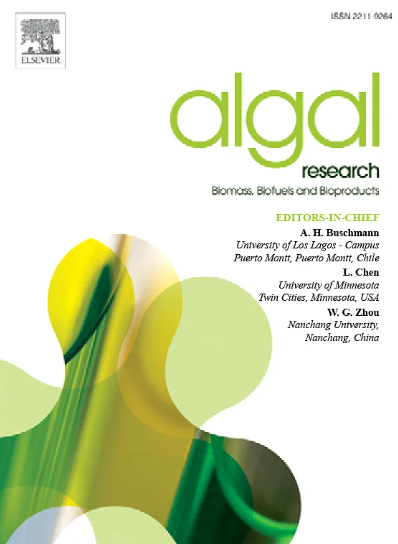Development of an estimation tool for monitoring growth and starch storage in microalgae cultures based on gas balance analysis
IF 4.6
2区 生物学
Q1 BIOTECHNOLOGY & APPLIED MICROBIOLOGY
Algal Research-Biomass Biofuels and Bioproducts
Pub Date : 2025-04-26
DOI:10.1016/j.algal.2025.104066
引用次数: 0
Abstract
Extensive research has been conducted on using microalgae biomass as a feedstock for biofuel production. Despite this, effective and accessible monitoring tools are still needed to track key energetic molecules, such as carbohydrates and lipids, to enhance and optimize the production of enriched biomass. This study presents the development and assessment of a three-compartment stoichiometric model designed as a monitoring tool for on-line estimation of growth kinetics and carbon reserve accumulation, primarily in the form of starch and, at later stages, triglycerides (TAGs). The proposed method leverages the indirect measurement of the net oxygen production rate and stoichiometric relationships governing the metabolic transitions within the bioprocess. It considers three key biomass components – catalytic biomass/cell structural components, starch, and TAGs – which accumulate sequentially over time during batch cultures under nitrogen-limiting conditions. The metabolic shift during nitrogen deprivation was modeled using well-defined kinetic terms. Model parameters were identified from two progressively nitrogen-starved batch cultures of Chlamydomonas reinhardtii and evaluated on an independent batch culture. While the model successfully captures key trends in nitrogen uptake, biomass formation, and carbon reserve accumulation (primarily as starch), its applicability to larger-scale systems with more complex environmental conditions remains to be further investigated. Nonetheless, this approach provides a promising foundation for real-time monitoring and bioprocess control strategies in microalgal cultivation.
基于气平衡分析的微藻生长和淀粉储存监测工具的开发
利用微藻生物量作为生物燃料生产的原料已经进行了广泛的研究。尽管如此,仍然需要有效和易于获取的监测工具来跟踪关键的能量分子,如碳水化合物和脂质,以增强和优化富集生物质的生产。本研究提出了一种三室化学计量模型的开发和评估,该模型被设计为在线估计生长动力学和碳储备积累的监测工具,主要以淀粉和后期甘油三酯(TAGs)的形式存在。该方法利用间接测量净产氧速率和控制生物过程中代谢转变的化学计量关系。它考虑了三种关键的生物质成分-催化生物质/细胞结构成分,淀粉和标签-它们在氮限制条件下分批培养过程中随着时间的推移而累积。利用定义明确的动力学项对氮剥夺过程中的代谢转移进行了建模。从两个逐渐缺氮的莱茵衣藻分批培养中确定模型参数,并在一个独立的分批培养中进行评估。虽然该模型成功捕获了氮吸收、生物量形成和碳储备积累(主要是淀粉)的关键趋势,但其对更复杂环境条件下更大规模系统的适用性仍有待进一步研究。尽管如此,该方法为微藻培养的实时监测和生物过程控制策略提供了有希望的基础。
本文章由计算机程序翻译,如有差异,请以英文原文为准。
求助全文
约1分钟内获得全文
求助全文
来源期刊

Algal Research-Biomass Biofuels and Bioproducts
BIOTECHNOLOGY & APPLIED MICROBIOLOGY-
CiteScore
9.40
自引率
7.80%
发文量
332
期刊介绍:
Algal Research is an international phycology journal covering all areas of emerging technologies in algae biology, biomass production, cultivation, harvesting, extraction, bioproducts, biorefinery, engineering, and econometrics. Algae is defined to include cyanobacteria, microalgae, and protists and symbionts of interest in biotechnology. The journal publishes original research and reviews for the following scope: algal biology, including but not exclusive to: phylogeny, biodiversity, molecular traits, metabolic regulation, and genetic engineering, algal cultivation, e.g. phototrophic systems, heterotrophic systems, and mixotrophic systems, algal harvesting and extraction systems, biotechnology to convert algal biomass and components into biofuels and bioproducts, e.g., nutraceuticals, pharmaceuticals, animal feed, plastics, etc. algal products and their economic assessment
 求助内容:
求助内容: 应助结果提醒方式:
应助结果提醒方式:


